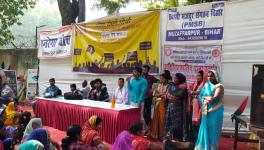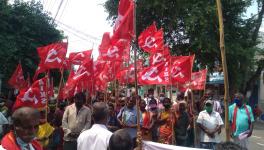Jaitley's Budget: Cuts for the Poor, Loan Waivers for the Rich

The 2017 union budget has very little in it for the working people. Demonetization has resulted in huge job losses due to the closure of small and medium scale industries, and severe retrenchment. With slow economic growth in last quarter of the year, it was expected that the government will provide concrete measures to revive demand and growth. But the budget provides very little. The increase in public investments is marginal and there are hardly any measures to improve the purchasing power of the people, which could have stimulated demand in the economy.
The government could have easily announced increase in minimum wage to at least Rs. 18000 per month, as proposed by the 7th Pay Commission. Instead, the government has continued to maintain that the minimum wage for unskilled workers should be only Rs. 12,000 per month for Tier-I cities, and even lower for others.
Government is continuing its policy of disinvestment and privatization of PSUs through various routes. In this Budget, Jaitley said the government plans to raise Rs. 72,500 crore through disinvestment of PSUs, including three Railway PSUs -- IRCTC, IRFC and IRCON. It is these PSUs, who are currently financing the railways by raising capital. Disinvesting from these means hitting the future expansion of the railways and making them inaccessible to the poorer section of the society.
The Budget does not outline any measure for recovering money from the companies who have created the current 6 lakh crore Non Performing Assets (NPA's) of the banks. It believes that the money returned to the banks by the people due to demonetisation, can now be used to “refinance” the banks and give further loans to the same defaulting business houses, who have created the NPA's in the first place.
The gender equity in the Budget is equally distorted. Even though the dairy industry and fisheries provide livelihood to many women, neither has specific allocations for women. Similarly, no other agricultural scheme has specific allocations for women, except the National Food Security Mission. Here too, the gender budget has a meagre increase of only Rs. 60 crore. Further, kerosene and LPG subsidies have a direct impact on women. The share of these in the total budget has come down from 9.5% in 2015-16 to 7.9% in 2017-18. There is also no gender budget component in any of these, except the LPG subsidy.
The finance minister has also ignored the problems of Aanganwadi workers, Asha workers and other scheme workers. The allocation to Anganwadis does not even compensate for the cuts since 2015-16, and in real terms shows a net decrease. This will even affect the Anganwadi workers’ payment of existing wages.
The government continues to remain unresponsive to the problems with cash transfers that has been brought to its notice repeatedly. Instead, it has proposed to increase the allocation of Rs 2,700 crore for maternity benefits, as a cash transfer scheme, conditional to women giving birth in formal medical facilities. Instead of helping women, this is in fact an attempt to provide public funds to private hospitals.
The government has overlooked the issue of women security. This is evident in the allocation cut in the Nirbhaya Fund from Rs. 585 crore in 2016-17 to Rs. 400 crore in the 2017-18.
With demonetisation, the country faced job loss at a large scale; a large number of people working in the informal sector returned to their villages. Creating employment, particularly rural employment, should have been the primary task in this Budget. MGNREGA is the most important rural employment programme of the government. In spite of Jailtley's tall claims of highest ever allocation of MNREGA, facts are otherwise. In this Budget, the MNREGA allocation is only Rs. 48,000 crore, as against last year's spending of Rs. 47,400 crores, an insignificant increase of only 1%. If we take inflation into account, this is actually lower than last year's allocation.
The practice of having a Plan allocation proportionate to the Scheduled Castes and Tribes population – as a part of Special Component Plan – has been discontinued with the scrapping of the Planning Commission. According to the National Campaign for Dalit Human Rights, if we take what would have been the equivalent of the Plan expenditure in this Budget, the budgetary allocations for the SC-ST Population proportion to their populations, should have been Rupees 91,386 crores and 47,276 crores respectively. But the current allocations are only 55% for the dalits – Rs 52,393 crore and 66.5% for the adivasis – Rs. 31,920 crore. Even here, the figures include spendings on other sectors, which do not benefit the dalits and the adivasis.
Even though there are reports that currently 18 million bonded-labourers exist in the country, this Budget has scrapped the bonded labour rehabilitation scheme. It has now been merged with grants to voluntary agencies for a wide range of activities. Similarly, ‘Swachh Bharat Abhiyan’, being a favourite programme of the PM, should have given major thrust for rehabilitation of manual scavengers. Instead, it has reduced the budget allocation by 50 percent – Rs 10 crore to 5 crore. There are approximately 2 lakh women who continue to be employed as dry-latrine workers. Obviously, such a small amount does not even touch the surface of the requirement of rehabilitation.
The Manuvadi attitude of this government can be further seen from its attitude to education for dalits. Pre-Matric scholarships for the SC students, which is a major incentive to arrest drop-out rates, has been reduced massively: from 510 crores in the last budget to a mere 50 crores. This will affect the future of the dalits, for whom education is a key need.
All in all, this Budget reveals the basic philosophy of this government. No measures to revive the economy from the shock of demonetisation; loan waivers for the rich, tax relief for the middle class; and serious cuts in the allocation for women, dalits and adivasis.
Get the latest reports & analysis with people's perspective on Protests, movements & deep analytical videos, discussions of the current affairs in your Telegram app. Subscribe to NewsClick's Telegram channel & get Real-Time updates on stories, as they get published on our website.
























